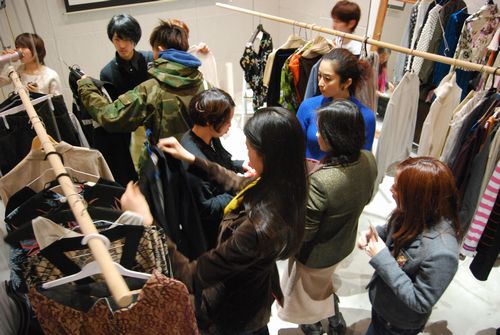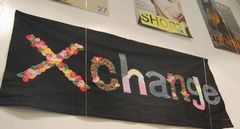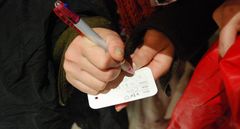April 14, 2009
"Fashion Swap" Concept Grows in Japan
Keywords: Newsletter
"xChange" -- Environment Meets the Fashion Industry --
JFS Newsletter No.79 (March 2009)
The Global Rise of the Fashion Swap
The practice of swapping fashions has recently been attracting attention worldwide, particularly in Europe and the United States. This is an activity aimed at making more effective use of resources by providing a forum for people to exchange free of charge those fashion items (clothes, shoes, bags, accessories, etc.) that they don't use anymore and that sit in their closets because, for instance, they no longer fit.
One example of a fashion-swapping event is the Swap-O-Rama-Rama, which started in the U.S. in 2005. Here, people exchange clothing and attend workshops to learn how to make modifications to secondhand clothes. In London, fashion swap events sponsored by the credit card company VISA focus on the swapping of specific brands.
Swap-O-Rama-Rama
http://www.swaporamarama.com/
Visa Swap
http://www.visaswap.com/
There are various sizes of fashion swap events -- from small ones among acquaintances to large ones sponsored by large companies. People and organizations -- ranging from non-governmental organizations to large firms -- interested in sustainable lifestyles while still enjoying dressing in style hold these events any format they wish. This freedom of style is one of the many attractions of fashion swaps.
The amount of clothes that each participant brings and takes away may vary, but they each bring their surplus articles and take home "new" ones. As goodwill spawns more goodwill, this type of activity works well socially, and is continuing to gain popularity throughout the world including Japan.
Fashion Swap Arrives in Japan

Japan's first major fashion swap event, "xChange," was held in September 2007 in Tokyo. Junko Niwa, a pioneer of this activity in Japan, explains the meaning of the name: "'X' means 'anything.' I hope that xChange will be a venue for exchanging anything, including ideas, knowledge, and convictions, in addition to clothes. I hope it will create something new and produce positive change."
xChange
http://letsxchange.jp/english
The xChange events are designed to exchange not only fashion items but also information and sentiments from the owners of the clothes, using what is called an "episode tag." Participants put tags on each of the items they bring and write their name and a brief episode concerning the tagged items.

For example, on the tag of a white jacket the former owner wrote, "This is a gift from a friend, but it's just not my style." On a tag attached to a pair of red pumps (shoes) a person wrote, "These don't fit me anymore. I hope someone who loves red can use them." Just as shoppers check price tags, some people check the episode tags before making a selection, first imagining who used to wear the item. The episode tags make people aware of the human connection -- something that can't be counted in monetary terms -- and also promote the exchange of feelings and communication by exchanging goods.
When asked for feedback, participants say things like, "I'm very lucky to get such lovely clothes for free," and "I was happy to see someone try on and choose what I brought here." Unwanted clothes for one person can be new and exciting for someone else. Plus, xChange achieves close to a 100-percent reuse rate by donating leftover clothes to companies that reuse or recycle secondhand clothing. Anything they cannot use, they then donate to developing countries or reuse them as rags.
Textile Production: Many Issues behind the Scenes
In the food industry, organic and "fair trade" products have attracted much attention, but this trend has not been as evident in the fashion industry. It is not widely known that the production of cotton, a major raw material for making clothing, actually causes major impacts on the environment. For instance, the amount of pesticides used for cotton production is said to be about 25 percent of total pesticide use worldwide. Cotton growing consumes large amounts of pesticides, insecticides, and chemical fertilizers. Defoliants are sometimes used to make cotton leaves fall off during the harvesting process. The heavy use of agrichemicals has inflicted serious damage on the environment where cotton is grown and on the health of farm workers.
In addition, some places suffer from water shortages due to overuse of water for irrigation, since cotton growing requires a large amount of water. The Aral Sea in Central Asia, for example, is drying up because of excessive water use for cotton growing.
Statistics indicate that the average Japanese buys ten kilograms and throws away nine kilograms of clothes a year, and over 2.1 million tons of textile products are reportedly incinerated and disposed of in landfills as burnable garbage each year in this country. It is also said that 80 percent of the time, most women wear only 20 percent of the clothes they own, which means most of their clothes are left sitting in their closets. The environmental impacts of the clothing industry are larger than most people imagine, if we consider all the processes from raw material procurement to product disposal.
Alternatives to Mass Production, Mass Consumption, and Mass Disposal
While acknowledging these problems, xChange's approach is to suggest ways of enjoying fashions that have less impact on both the environment and the producers of clothing materials, rather than emphasizing restraint and regulation. The purpose of the xChange event is not to suggest that people "try to avoid buying clothes." Instead, it aims to encourage women to continue taking good care of their clothes, and let their unneeded-but-still-wearable clothes be used by someone else instead of discarding them. One of the xChange's core messages is: "Let's minimize waste and change our ways of consumption."
Another message is: "Let's think about our connections to material things." This means considering where the goods we use come from and where they go afterwards, and what effects the act of purchasing goods has on the environment and the producers of the goods. "It is crucial to be aware of the fact that our purchases could unintentionally lead to environmental destruction and poverty. If we are aware of that, we will probably try to take better care of our belongings," says Niwa.
Although the xChange's fashion swap is an exchange of goods in the traditional sense, we could also see it as a new attempt in the context of our modern society, which is built upon the global market and the monetary economy. This event promotes lifestyles that use material goods in a simpler but more enriched way, by restoring basic human communication and reconsidering the existing social systems that are based on mass production, mass consumption, and mass disposal.
Expanding Ethical Fashion Brands
In addition to offering a venue to exchange secondhand clothes, the xChange events also introduce ethical fashion brands, which are produced in ways that are conscious of both the environment and the working conditions of producers. These brand clothes are made of organic materials produced with reduced impacts on the environment and under a regime free from child or underpaid labor -- in order to keep production in line with ethical and moral standards.
A popular ethical fashion brand in Japan is the People Tree brand of the Fair Trade Co., which sells through 350 retailers across the country, and also offers catalog and online sales. Since its foundation in 1995, the company has implemented fair trade principles, by which it purchases goods produced in environmentally conscious ways from countries in Asia, Africa, and South America, and sells them in Japan. As sign of the growing interest in ethical fashions, its founder, Safia Minney, was chosen by the Japanese edition of Newsweek in 2007 as one of the top 100 social entrepreneurs changing the world.
People Tree
http://www.peopletree.co.jp/ (Japan)
http://www.peopletree.co.uk/ (UK)
Since its start in September 2007, the xChange event has been held every two or three months in a different region of Japan, always attracting many participants. This success is probably because anyone can easily participate, and also because it is an active event that gives participants opportunities to enjoy fashion without increasing the impact on the environment -- or their pocketbooks. Niwa, expresses her ambitions by saying, "I hope to turn this into a larger and more profound movement by collaborating with entrepreneurs, artists, journalists, fashion and beauty schools, corporate sponsors, local governments, and so on." She added, "I also hope to create a venue where people can exchange not only clothes but also daily-use items."
Many eyes here are watching fashion industry trends and the xChange movement, which holds much promise of continued growth.
Written and photo taken by Keiko Hoshino
Related
"JFS Newsletter"
- 'Good Companies in Japan' (Article No.4): 'Eightfold Satisfaction' Management for Everyone's Happiness
- "Nai-Mono-Wa-Nai": Ama Town's Concept of Sufficiency and Message to the World
- 'Yumekaze' Wind Turbine Project Connects Metro Consumers and Regional Producers: Seikatsu Club Consumers' Co-operative
- Shaping Japan's Energy toward 2050 Participating in the Round Table for Studying Energy Situations
- 'Good Companies in Japan' (Article No.3): Seeking Ways to Develop Societal Contribution along with Core Businesses


